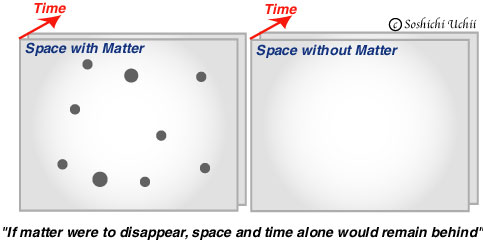

Brief History of Space
Appendix Five: Relativity and the Problem of Space
This Appendix is rather philosophical, and Einstein gives a brief survey of the problem of space (and time) in physics up to general relativity. It is instructive to learn historical facts as well as Einstein's view on the matter.
First, he presents the classical (Newtonian) view of space and time:

How was this view modified, when the electromagnetic theory appeared in the 19th century?
Because of the nature of electromagnetism, aether was supposed to be at rest in space, thus the Newtonian absolute space was identified with the space filled with aether.
You now know that this picture was discarded by the appearance of special relativity.
Although this may give the impression that the "absolute" or "independent" character of space and time is completely discarded by special relativity, that is not so. For, the validity of special relativity is restricted to inertial systems. Thus, Einstein claims:
...as in classical mechanics, space is here also an independent component in the representation of physical reality. If we imagine matter and field to be removed, inertial-space or, more accurately, this space together with the associated time remains behind. The four-dimensional structure (Minkowski-space) is thought of as being the carrier of matter and of the field. (171)
Then, what is the situation after general relativity is introduced? Einstein discarded the restriction of inertial systems; a frame in any continuous motion (accelerated motion) may be used as a reference frame.
As is clear from the figure, a new reference frame (t', s') by itself does not have a physical significance; it can serve as a reference frame only together with the gravitational field expressed in terms of metric g_ik. In other words, the geometry of this system entirely depends on the metric. Or we may put it this way: a free motion in either system is physically the same, but it may be described differently depending on a chosen coordinate system; however, in order to keep the same physical content, the metric relative to that system must be adjusted accordingly. Generalizing this sort of consideration, Einstein thus claims:
On the basis of general relativity, ..., space as opposed to "what fills space," which is dependent on the co-ordinates, has no separate existence. Thus a pure gravitational field might have been described in terms of the g_ik (as functions of the co-ordinates), by solution of the gravitational equations. If we imagine the gravitational field, i.e. the functions g_ik, to be removed, there does not remain a space ..., but absolutely nothing, and also no "topological space". For the functions g_ik describe not only the field, but at the same time also the topological and metrical structural properties of the manifold. ... There is no such thing as an empty space, i.e. a space without field. Space-time does not claim existence on its own, but only as a structural quality of the field. (176)
Last modified, August 27, 2002. (c) Soshichi Uchii